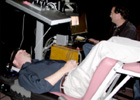 |
 |
 |
| The mission of the Human Vibration Laboratory is to assess whole-body vibration impacts on visual, cognitive, and manual performance, understand the mechanisms contributing to vibration-induced performance deficits, and develop countermeasures to mitigate these deficits. |
|
 |

|
 |
| |
 |
 The objective of the Human Vibration Laboratory is to assess whole-body vibration impacts on visual, cognitive, and manual performance, understand the mechanisms contributing to vibration-induced performance deficits, and develop countermeasures to mitigate these deficits. The objective of the Human Vibration Laboratory is to assess whole-body vibration impacts on visual, cognitive, and manual performance, understand the mechanisms contributing to vibration-induced performance deficits, and develop countermeasures to mitigate these deficits.
The laboratory is equipped with a recumbent vibration chair that can deliver single-frequency and complex broadband motion to seat occupants in up to three degrees-of-freedom (vertical, pitch, and roll). Large-area video panels positioned above the seat display visual stimuli to experiment participants. Participants provide manual task inputs via the video panels' touchscreen faces, joysticks, or other input devices. High-speed high-resolution video recording enables monitoring of head and eye movements consequent to whole-body vibration.
The lab's chair, video panel, and available manual controller configuration permits display format and operation concepts to be examined for space-launch vibration environments. A parallel configuration at the Ames 20-G Centrifuge allows studies to also include elevated G-loading. |
|
|
|
|